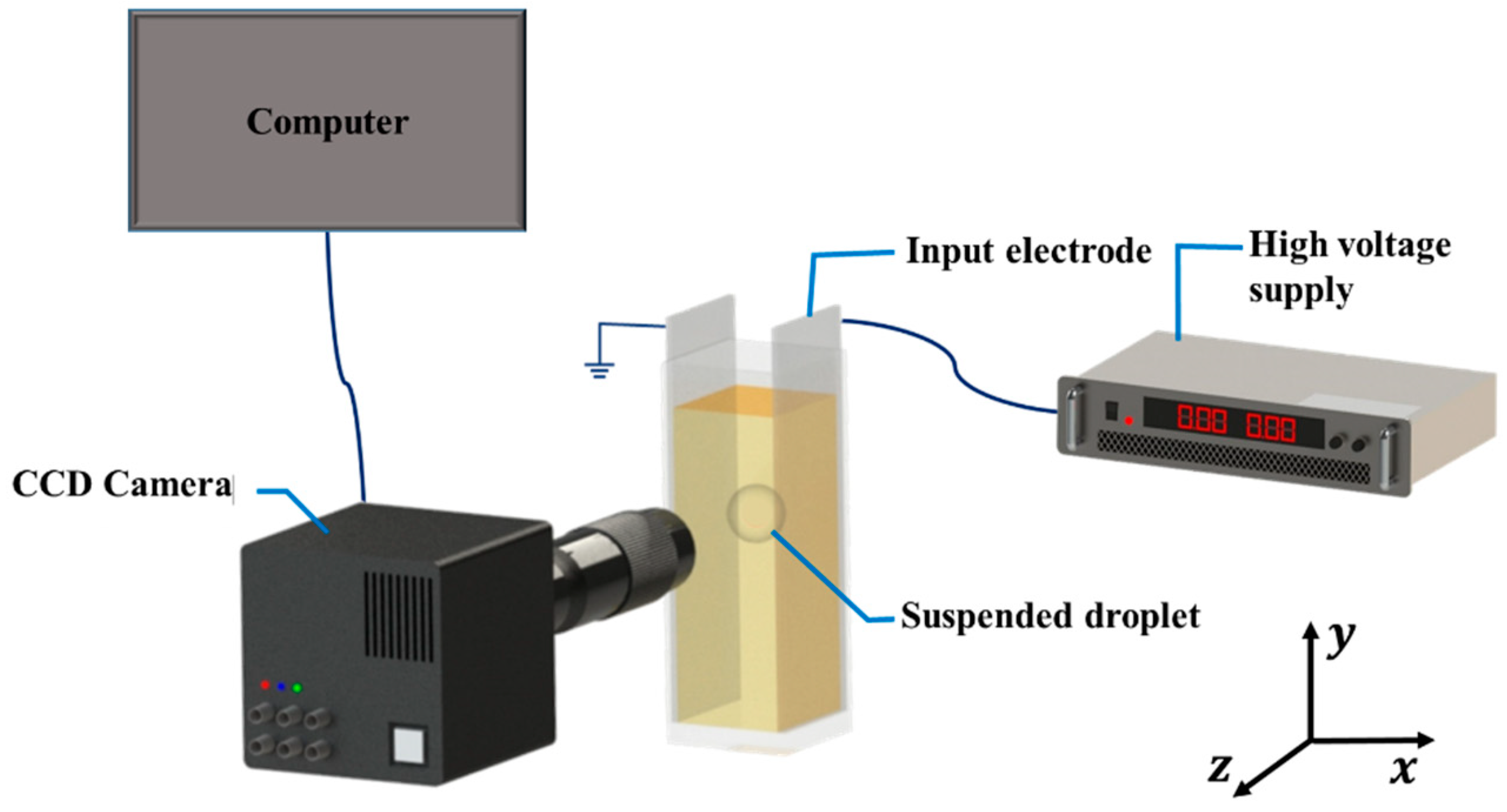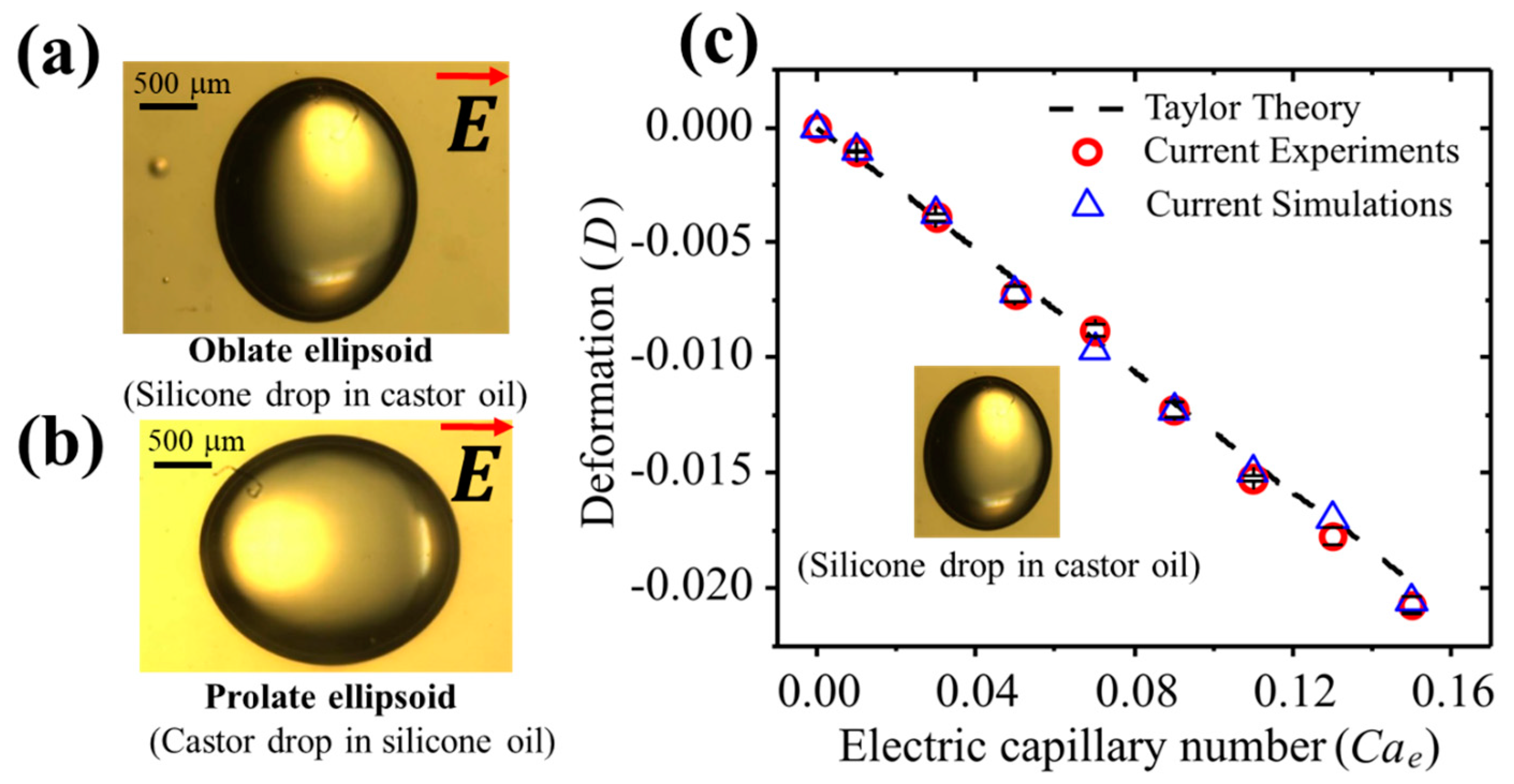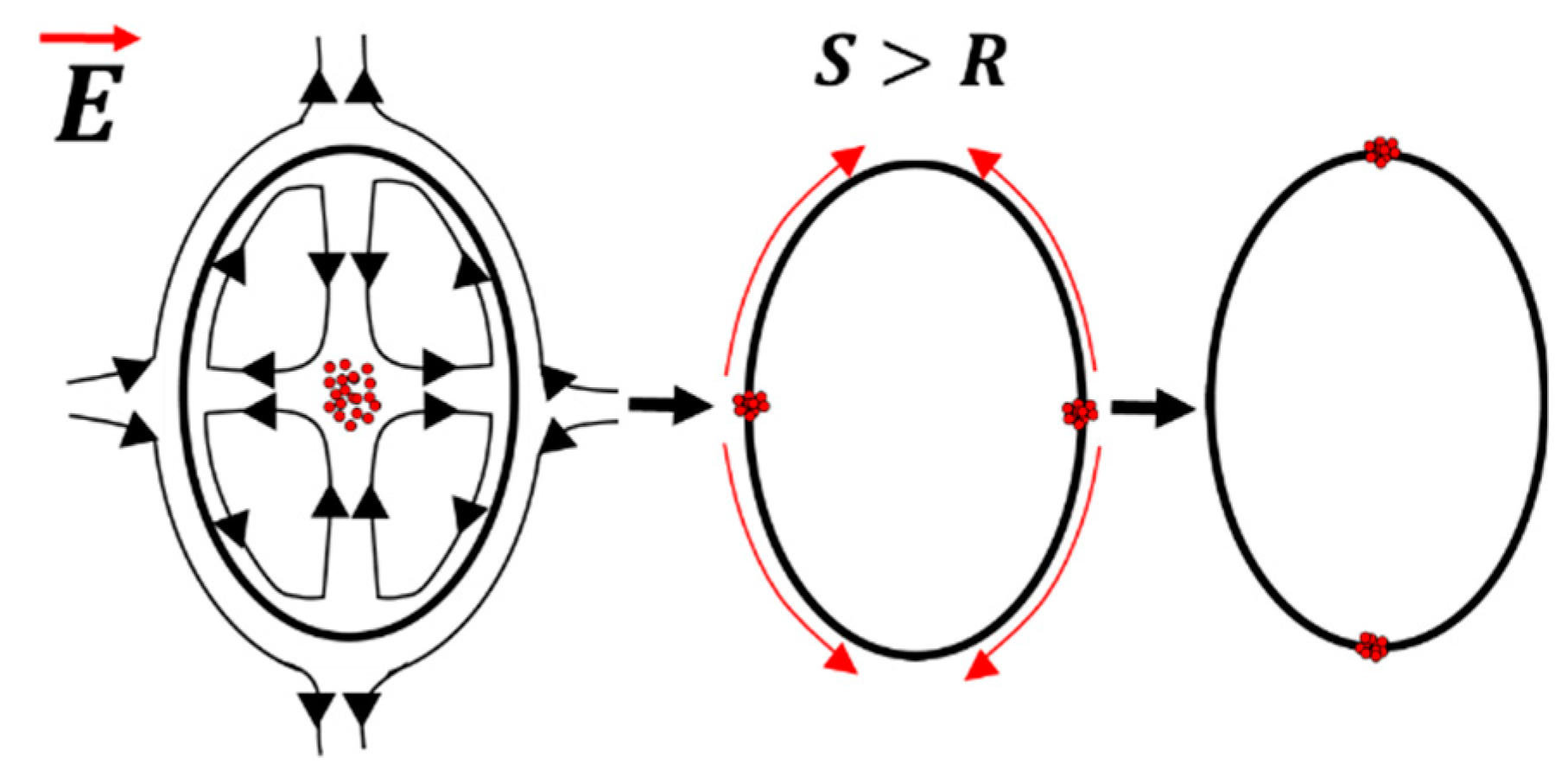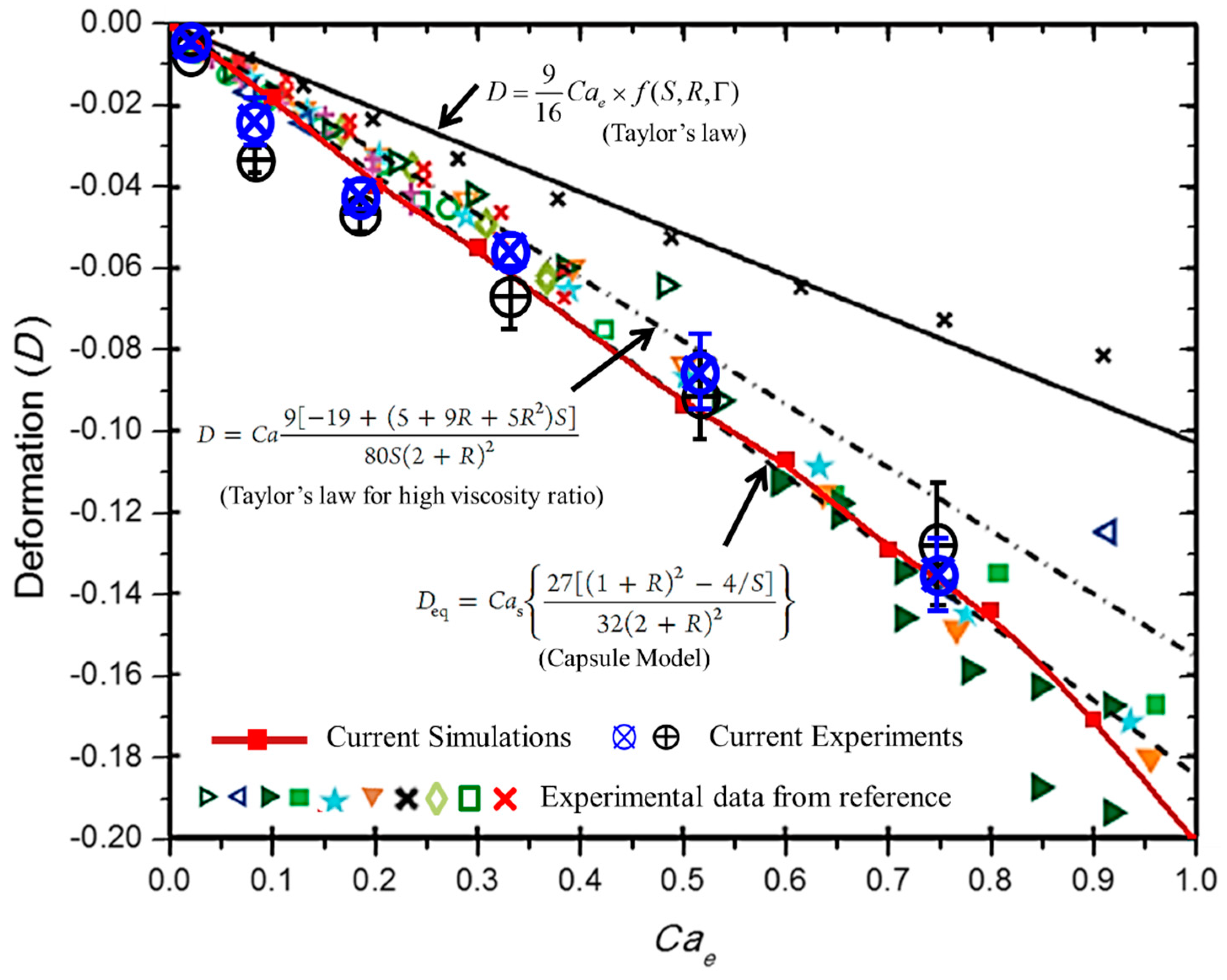Deformation of Emulsion Droplet with Clean and Particle-Covered Interface under an Electric Field
Abstract
:1. Introduction
2. Materials and Methods
2.1. Experimental Scheme
2.2. Preparation of Suspension
2.3. Simulation
2.4. Theory
3. Results and Discussion
4. Conclusions
Supplementary Materials
Author Contributions
Funding
Conflicts of Interest
References
- Sadeh, P.; Najafipour, I.; Gholami, M.J.C.; Physicochemical, S.A.; Aspects, E. Adsorption kinetics of halloysite nanotube and modified halloysite at the Palm oil-water interface and Pickering emulsion stabilized by halloysite nanotube and modified halloysite nanotube. Colloids Surf. A Physicochem. Eng. Asp. 2019, 577, 231–239. [Google Scholar] [CrossRef]
- Tummons, E.N.; Hejase, C.A.; Yang, Z.; Chew, J.W.; Bruening, M.L.; Tarabara, V.V. Oil droplet behavior on model nanofiltration membrane surfaces under conditions of hydrodynamic shear and salinity. J. Colloid Interface Sci. 2020, 560, 247–259. [Google Scholar] [CrossRef] [PubMed]
- Abbasi, M.S.; Song, R.; Kim, H.; Lee, J. Multimodal breakup of a double emulsion droplet under an electric field. Soft Matter 2019, 15, 2292–2300. [Google Scholar] [CrossRef] [PubMed]
- Abbasi, M.S.; Song, R.; Kim, J.; Lee, J. Electro-hydrodynamic behavior and interface instability of double emulsion droplets under high electric field. J. Electrost. 2017, 85, 11–22. [Google Scholar] [CrossRef]
- Abbasi, M.S.; Song, R.; Kim, S.-M.; Kim, H.; Lee, J. Mono-emulsion droplet stretching under direct current electric field. Soft Matter 2019, 15, 2328–2335. [Google Scholar] [CrossRef] [PubMed]
- Melcher, J.; Taylor, G. Electrohydrodynamics: A review of the role of interfacial shear stresses. Annu. Rev. Fluid Mech. 1969, 1, 111–146. [Google Scholar] [CrossRef]
- Taylor, G. Disintegration of water drops in an electric field. Proc. R. Soc. Lond. Ser. A Math. Phys. Sci. 1964, 280, 383–397. [Google Scholar]
- Taylor, G. Studies in electrohydrodynamics. I. The circulation produced in a drop by electrical field. Proc. R. Soc. Lond. Ser. A Math. Phys. Sci. 1966, 291, 159–166. [Google Scholar]
- Tomar, G.; Biswas, G.; Sharma, A.; Welch, S. Influence of electric field on saturated film boiling. Phys. Fluids 2009, 21, 032107. [Google Scholar] [CrossRef]
- Torza, S.; Cox, R.; Mason, S. Electrohydrodynamic deformation and bursts of liquid drops. Phil. Trans. R. Soc. Lond. A 1971, 269, 295–319. [Google Scholar]
- Abbasi, M.S.; Song, R.; Lee, J. Breakups of an encapsulated surfactant-laden aqueous droplet under a DC electric field. Soft Matter 2019, 15, 8905–8911. [Google Scholar] [CrossRef]
- Ajayi, O. A note on Taylor’s electrohydrodynamic theory. Proc. R. Soc. Lond. A 1978, 364, 499–507. [Google Scholar]
- Zhang, J.; Zahn, J.D.; Lin, H. Transient solution for droplet deformation under electric fields. Phys. Rev. E 2013, 87, 043008. [Google Scholar] [CrossRef] [PubMed] [Green Version]
- O’Konski, C.T.; Thacher, H.C., Jr. The distortion of aerosol droplets by an electric field. J. Phys. Chem. 1953, 57, 955–958. [Google Scholar] [CrossRef]
- Eow, J.S.; Ghadiri, M. The behaviour of a liquid–liquid interface and drop-interface coalescence under the influence of an electric field. Colloids Surf. A Physicochem. Eng. Asp. 2003, 215, 101–123. [Google Scholar] [CrossRef]
- Lakshmanan, S.; Gupta, G.K.; Avci, P.; Chandran, R.; Sadasivam, M.; Jorge, A.E.S.; Hamblin, M.R. Physical energy for drug delivery; poration, concentration and activation. Adv. Drug Deliv. Rev. 2014, 71, 98–114. [Google Scholar] [CrossRef] [Green Version]
- Deng, X.; Ren, Y.; Hou, L.; Liu, W.; Jiang, T.; Jiang, H.J.S. Compound-Droplet-Pairs-Filled Hydrogel Microfiber for Electric-Field-Induced Selective Release. Small 2019, 15, 1903098. [Google Scholar] [CrossRef]
- Chen, C.-H.; Shah, R.K.; Abate, A.R.; Weitz, D.A. Janus Particles Templated from Double Emulsion Droplets Generated Using Microfluidics. Langmuir 2009, 25, 4320–4323. [Google Scholar] [CrossRef]
- Huo, M.; Guo, Y.J.P. Electric Field Enhances Shear Resistance of Polymer Melts via Orientational Polarization in Microstructures. Polymers 2020, 12, 335. [Google Scholar] [CrossRef] [Green Version]
- San Miguel, A.; Scrimgeour, J.; Curtis, J.E.; Behrens, S.H. Smart colloidosomes with a dissolution trigger. Soft Matter 2010, 6, 3163–3166. [Google Scholar] [CrossRef]
- Xie, J.; Jiang, J.; Davoodi, P.; Srinivasan, M.P.; Wang, C.-H. Electrohydrodynamic atomization: A two-decade effort to produce and process micro-/nanoparticulate materials. Chem. Eng. Sci. 2015, 125, 32–57. [Google Scholar] [CrossRef] [PubMed] [Green Version]
- Ahn, K.; Kerbage, C.; Hunt, T.P.; Westervelt, R.; Link, D.R.; Weitz, D. Dielectrophoretic manipulation of drops for high-speed microfluidic sorting devices. Appl. Phys. Lett. 2006, 88, 024104. [Google Scholar] [CrossRef] [Green Version]
- Song, R.; Abbasi, M.S.; Lee, J.J.M. Fabrication of 3D printed modular microfluidic system for generating and manipulating complex emulsion droplets. Microfluid. Nanofluidics 2019, 23, 92. [Google Scholar] [CrossRef]
- Dommersnes, P.; Rozynek, Z.; Mikkelsen, A.; Castberg, R.; Kjerstad, K.; Hersvik, K.; Fossum, J.O. Active structuring of colloidal armour on liquid drops. Nat. Commun. 2013, 4, 2066. [Google Scholar] [CrossRef] [Green Version]
- Mikkelsen, A.; Dommersnes, P.; Rozynek, Z.; Gholamipour-Shirazi, A.; Carvalho, M.d.S.; Fossum, J.O.J.M. Mechanics of Pickering drops probed by electric Field–Induced Stress. Materials 2017, 10, 436. [Google Scholar] [CrossRef] [Green Version]
- Mikkelsen, A.; Wojciechowski, J.; Rajňák, M.; Kurimský, J.; Khobaib, K.; Kertmen, A.; Rozynek, Z.J.M. Electric field-driven assembly of sulfonated polystyrene microspheres. Materials 2017, 10, 329. [Google Scholar] [CrossRef] [Green Version]
- Bentenitis, N.; Krause, S. Droplet deformation in dc electric fields: The extended leaky dielectric model. Langmuir 2005, 21, 6194–6209. [Google Scholar] [CrossRef]
- Aveyard, R.; Binks, B.P.; Clint, J.H.J.A.i.C.; Science, I. Emulsions stabilised solely by colloidal particles. Adv. Colloid Interface Sci. 2003, 100, 503–546. [Google Scholar] [CrossRef]
- Binks, B.P. Particles as surfactants—Similarities and differences. Curr. Opin. Colloid Interface Sci. 2002, 7, 21–41. [Google Scholar] [CrossRef]
- Nudurupati, S.; Janjua, M.; Aubry, N.; Singh, P.J.E. Concentrating particles on drop surfaces using external electric fields. Electrophoresis 2008, 29, 1164–1172. [Google Scholar] [CrossRef]
- Nudurupati, S.; Janjua, M.; Singh, P.; Aubry, N.J.S.m. Effect of parameters on redistribution and removal of particles from drop surfaces. Soft Matter 2010, 6, 1157–1169. [Google Scholar] [CrossRef]
- Ouriemi, M.; Vlahovska, P. Electrohydrodynamics of particle-covered drops. J. Fluid Mech. 2014, 751, 106–120. [Google Scholar] [CrossRef]
- Ouriemi, M.; Vlahovska, P.M. Electrohydrodynamic deformation and rotation of a particle-coated drop. Langmuir 2015, 31, 6298–6305. [Google Scholar] [CrossRef] [PubMed] [Green Version]
- Ha, J.-W.; Yang, S.-M. Electrohydrodynamic effects on the deformation and orientation of a liquid capsule in a linear flow. Phys. Fluids 2000, 12, 1671–1684. [Google Scholar] [CrossRef] [Green Version]
- Erni, P.; Jerri, H.A.; Wong, K.; Parker, A. Interfacial viscoelasticity controls buckling, wrinkling and arrest in emulsion drops undergoing mass transfer. Soft Matter 2012, 8, 6958–6967. [Google Scholar] [CrossRef]
- Shi, Y.; Tang, G.H.; Cheng, L.H.; Shuang, H.Q. An improved phase-field-based lattice Boltzmann model for droplet dynamics with soluble surfactant. Comput. Fluids 2019, 179, 508–520. [Google Scholar] [CrossRef]
- Sedaghatkish, A.; Sadeghiseraji, J.; Jamalabadi, M.Y.A.J.I.J.o.H.; Transfer, M. Numerical simulation of magnetic nanofluid (MNF) film boiling on cylindrical heated magnet using phase field method. Int. J. Heat Mass Transfer. 2020, 152, 119546. [Google Scholar] [CrossRef]
- Olsson, E.; Kreiss, G.; Zahedi, S. A conservative level set method for two phase flow II. J. Comput. Phys. 2007, 225, 785–807. [Google Scholar] [CrossRef]
- Olsson, E.; Kreiss, G. A conservative level set method for two phase flow. J. Comput. Phys. 2005, 210, 225–246. [Google Scholar] [CrossRef]
- Vella, D.; Aussillous, P.; Mahadevan, L.J.E. Elasticity of an interfacial particle raft. Europhys. Lett. 2004, 68, 212. [Google Scholar] [CrossRef] [Green Version]
- Planchette, C.; Lorenceau, E.; Biance, A.-L.J.S.M. Surface wave on a particle raft. Soft Matter 2012, 8, 2444–2451. [Google Scholar] [CrossRef]
- Cicuta, P.; Vella, D.J.P.r.l. Granular character of particle rafts. Phys. Rev. Lett. 2009, 102, 138302. [Google Scholar] [CrossRef] [PubMed] [Green Version]








| Liquid | Mass Density (kg/m3) | Dynamic Viscosity (Pa.s) | Electrical Conductivity (S/m) | Dielectric Constant |
|---|---|---|---|---|
| Castor Oil | 961 | 0.78 | 3 × 10−11 | 4.7 |
| Silicone Oil | 970 | 0.97 | 0.87 × 10−13 | 3.2 |
| System | Dispersed Phase | Continuous Phase | Conductivity Ratio (R) | Permittivity Ratio (S) | |
|---|---|---|---|---|---|
| CS | Castor oil | Silicone oil | 34.48 | 1.47 | 0.804 |
| SC | Silicone oil | Castor oil | 0.68 | 0.029 | 1.24 |
© 2020 by the authors. Licensee MDPI, Basel, Switzerland. This article is an open access article distributed under the terms and conditions of the Creative Commons Attribution (CC BY) license (http://creativecommons.org/licenses/by/4.0/).
Share and Cite
Abbasi, M.S.; Farooq, H.; Ali, H.; Kazim, A.H.; Nazir, R.; Shabbir, A.; Cho, S.; Song, R.; Lee, J. Deformation of Emulsion Droplet with Clean and Particle-Covered Interface under an Electric Field. Materials 2020, 13, 2984. https://doi.org/10.3390/ma13132984
Abbasi MS, Farooq H, Ali H, Kazim AH, Nazir R, Shabbir A, Cho S, Song R, Lee J. Deformation of Emulsion Droplet with Clean and Particle-Covered Interface under an Electric Field. Materials. 2020; 13(13):2984. https://doi.org/10.3390/ma13132984
Chicago/Turabian StyleAbbasi, Muhammad Salman, Haroon Farooq, Hassan Ali, Ali Hussain Kazim, Rabia Nazir, Aqsa Shabbir, Seongsu Cho, Ryungeun Song, and Jinkee Lee. 2020. "Deformation of Emulsion Droplet with Clean and Particle-Covered Interface under an Electric Field" Materials 13, no. 13: 2984. https://doi.org/10.3390/ma13132984
APA StyleAbbasi, M. S., Farooq, H., Ali, H., Kazim, A. H., Nazir, R., Shabbir, A., Cho, S., Song, R., & Lee, J. (2020). Deformation of Emulsion Droplet with Clean and Particle-Covered Interface under an Electric Field. Materials, 13(13), 2984. https://doi.org/10.3390/ma13132984






